[on.cc East Net News]In mountain search and rescue and collapse sites, there will always be search and rescue dogs from the Fire Department. The Fire Services Department currently has 6 search-and-rescue dogs, two of which are self-bred, and the remaining 4 are imported dogs that have completed training. One of the search-and-rescue dogs, Umi, is only 2 years old this year, but it has been on missions many times. Including Uma, another self-bred search and rescue dog, who assisted in the search for missing hikers at Blade Ridge in Clear Water Bay in July last year; in August of the same year, they assisted in the search and rescue amidst the rubble at the North Village Warehouse in Fanling Army Site; In February, he and his search and rescue dog teammate Twix went to the earthquake-stricken area in Turkey with the Hong Kong rescue team and rescued 4 survivors. Drawing on the experience of disaster relief in Turkey, the Fire Services Department adjusted its rescue strategy, simulated a more realistic collapse disaster site environment, and improved its training level.
Umi, two years old, is one of the first batch of working dogs successfully bred by the Fire Services Department and Customs in 2021. Umi is a Springer Spaniel with a small body. Its dog leader Chen Zhukuang said: “The Springer Spaniel has a particularly sensitive sense of smell and quick movements. It can quickly search in a large area and accurately judge the smell of humans, which greatly shortens the time needed to confirm the location. Time.” In addition to their inherent advantages, they also receive daily training and practice at the Fire and Rescue Academy Collapse Search and Rescue Training Ground to adapt to searching for people in different situations and under sound interference. Drawing on the experience of disaster relief in Turkey, the Fire Services Department adjusted its strategy and simulated a more realistic collapse disaster site environment for training. Chen Zhukuang explained: “The disaster site has the smell of food and clothing, and there may also be heavy machinery, noise, fire, etc. We add these elements in the training ground, so that the search and rescue dogs can do more interference training, so that they can be more focused during the official search and rescue.”
Mountain search and rescue is also an important part of search and rescue dog training. In fact, mountain rescue accidents in Hong Kong have increased significantly in recent years. There were only 242 in 2018, compared to 1,014 last year. Search and rescue dogs used to detect human scents in the form of large-scale searches, but because there is no designated target, the search and rescue requires a lot of physical exertion. In view of this, the Fire Services Department adopted a new tracking training at the beginning of last year, allowing search and rescue dogs to focus on searching for a scent during mountain search and rescue training. Chen said: “In the actual search and rescue operations, we will go to the homes of the missing persons to collect items with their scent, such as pillowcases, shoes and clothing, so that the search and rescue dogs can remember the smell before tracking, so as to reduce their physical exertion.” Fire Services Department He said that the dogs bred at home can better meet the training needs, and he hopes to breed a new generation of search and rescue dogs in the future to protect Hong Kong people.

[FormoreinstantnewsdetailspleasegotoEast Net News】


